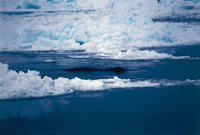Like a stream of massive torpedoes, thousands of blubbery dynamos are making a southwest migration through the icy Arctic Ocean. They’re bowhead whales heading toward winter haunts in the Bering Sea, just north of the Aleutian Islands.
Along the way, Inupiat Eskimos in Alaska will legally harvest several of these endangered mammals—30-to-60-foot-long behemoths that sometimes tip the scales at 50 tons or more.
Having hunted these whales for centuries, the Inupiat are keen observers of the bowhead (Balaena mysticetus). Their tales recall whales that hunters had recognized by distinctive scars. In some cases, several generations of storytellers described encountering the same whale, leading to speculation that bowheads might live some 60 years.
Studies now suggest that these whales can actually outlive people—perhaps by a century.
Ancient points

The new research was triggered by hunters finding ancient harpoon points in the foot-thick blubber of newly landed whales. Six points made of stone or ivory have turned up since 1981. None of the Inupiat subsistence whalers could remember having seen such primitive tools used.
“You have to understand that [the Inupiat] are technological pickpockets,” quips biologist David W. Norton, with a grin of respect. Now working in Fairbanks, he conducted research in Barrow, Alaska, over roughly 3 decades. During that time, he saw Inupiat hunters in Alaska’s northernmost county, the North Slope Borough, quickly embrace any useful technology to which they were exposed. Indeed, history shows that as soon as Inupiat whalers gained access to metal, around 1870, they swapped it for stone and ivory in their tools.
Against that backdrop, the old harpoon points suggest that at least some contemporary bowheads are survivors of run-ins with whalers 100 years earlier, observes biologist Todd M. O’Hara of the borough’s Department of Wildlife Management in Barrow.
To investigate this provocative possibility, O’Hara’s colleague J. Craig George began looking for a way to determine the age of elder bowheads. A little research led him to Jeffrey L. Bada of the Scripps Institution of Oceanography in La Jolla, Calif.
A geochemist, Bada has been refining a technique for dating fossils on the basis of changes in their aspartic acid. This amino acid can exist in either of two mirror-image forms. Living things make and use only the left-handed version. However, after death, a body’s aspartic acid gradually converts to a 50-50 mix of the two forms. In fossils, that conversion takes about 1 million years.

Bada’s team had shown that this change in the ratio also occurs in living animals’ body parts that are not undergoing metabolism, such as teeth and the lens of the eye. In such tissues, body heat sets the pace of change in the ratio of left-handed to right-handed aspartic acid.
Indeed, the conversion rate appears to be identical in the lenses of all animals with the same basic body temperature. The scientists have tested more than 20 species, including people and bowhead whales. Bada offered to help calculate the age of North Slope bowheads from that ratio of the two forms of aspartic acid in eye lenses.
George sent tissues from 48 bowhead whales to Bada without letting him know whether each had come from an infant, juvenile, young adult, or mature adult. The chemist’s assays accurately dated the relative age of the young whales and indicated that most adults had been 20 to 60 years old at death. However, the lens analyses from five large males suggested that at the time that I±upiat hunters harpooned them, one was 90, four were between 135 and 180, and one was more than 200 years old.

Recent recruits
O’Hara’s group has recently recruited two other research teams to apply other techniques to estimate bowhead ages.
Next month, for instance, Mark Baskaran of Wayne State University in Detroit expects to start measuring radioactive lead in samples of bowhead bone. The lead isotope forms during the decay of radium, a naturally occurring calciumlike radionuclide in seawater. Because both the radium and lead decay at known rates, Baskaran can use their ratio to determine the age of bones more than a year old.
Cheryl Rosa of the University of Alaska, Fairbanks plans to assay pentosidine in samples of whales’ skin. Aging leads to a progressive build-up of this chemical in many animals’ skin. Rosa envisions eventually using it to determine the ages of living whales. A tethered dart can extract a small chunk of skin from a passing animal. Rosa notes, “The whale doesn’t even seem to notice.”
Bada points out that these complementary studies are important to confirm the longevity indicated by his work. They might even provide further surprises. Unless whales’ eyes are much warmer than people’s and therefore have a faster aspartic acid conversion rate, Bada says, “what we have assigned the bowheads are only minimum ages—which is staggering! These are truly aged animals, perhaps the most long-lived mammals.”
However, he points out that other members of the whale family may also have the capacity to be centenarians, even if they don’t live as long as bowheads. Bada claims to have “a bunch of pretty compelling data” to suggest several other whales can get “quite old.”






